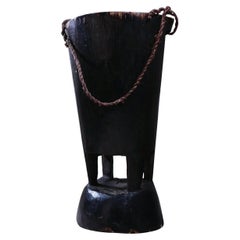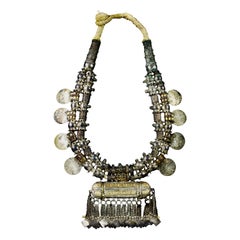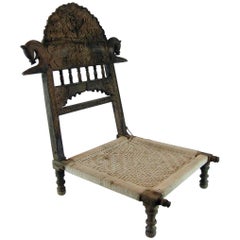Rope Tribal Art
2
to
1
1
2
2
2
1
1
1,498
598
297
171
118
1
1
1
1
1
Material: Rope
Lozi Milk Jug
Located in Richmond, VA
The Loss people of Zambia are known for their basketry and rarely work in wood, but their wooden milk jugs are sought after objects from collectors. Originally used to collect milk f...
Category
20th Century Zambian Rope Tribal Art
Materials
Rope, Wood
Oman, Necklace, 19th Century
Located in PARIS, FR
Stunning and rare Omani tribal necklace in gold and silver featuring eight Burgau thalers dated 1780. 19th century.
Very good condition. Preserved and professionally framed.
Dimensions of the necklace: 52 x 30 x 3
Dimensions of the frame: 70 x 47 x 5
Secure shipping.
This fine Omani necklace of silver and gold comprises two strands of spiky, seed pod-like silver beads; gold-wrapped beads; eight silver Maria Theresa thaler coins; and a large silver and gold amulet box, with multiple chain tassels each of which finishes with a square-shaped pendant cut from sheet silver.
The cigar-shaped amulet box called hirz would have contained some Koranic verse or religious text.
Such a spectacular display of wealth would only have been worn at times of important festivities such as marriage celebrations.
Maria Theresa thalers were made in Austria since the reign of Empress Maria Theresa of the Austro-Hungarian Empire. The Empress died in 1780 and since that time, all thalers that were subsequently struck were minted with that date regardless of the actual year that they were produced. The coins achieved such a level of trust for their silver content (which is 83.3% silver) in the Middle East that neither the design not the date was varied, and so for more than 200 years the coins were used as an international currency among the tribes and the states of the Middle East, in much the same way as the Spanish dollar was used as an international currency at the time elsewhere. The thalers were used to complete most important transactions locally and were also given as dowries. They were also an important source of silver and were melted locally for jewellery.
The coins made their way to the ports of the Red Sea, Egypt and northern Africa from the ports of Genoa, Trieste, Livorno and Marseille. European traders used the coins to buy precious materials from the Gulf and northern Africa which it desired – commodities such as spices, coffee, gum Arabic, indigo, pearls, and tortoise shell.
The importance and the beauty of the coins saw them incorporated into local jewellery most particularly in Oman and Yemen.
References
Al-Jadir, S., Arab & Islamic Silver, Stacey International, 1981.
Harrigan, P., ‘Tales of a Thaler’, Saudi Aramco World, January/February 2003.
Hawley, R., Omani Silver, Longman, 1978.
Hawley, R., Silver: The Traditional Art of Oman, Stacey International, 2000.
Rajab, J.S., Silver Jewellery of Oman, Tareq Rajab Museum, 1998.
Ransom, M., Silver Treasures from the Land of Sheba: Regional Yemeni Jewelry...
Category
19th Century Omani Antique Rope Tribal Art
Materials
Gold, Silver
Related Items
19th Century Brass Pendant on Yellow Multi-Strand Beaded Necklace, Naga, India
Located in Point Richmond, CA
19th century brass pendant on yellow multi-strand beaded necklace, Naga, India
A graceful necklace of small yellow glass trade beads bead...
Category
Early 20th Century Indian Tribal Rope Tribal Art
Materials
Brass
Bronze Head of an Oba, Yoruba People, 1950s
Located in Aramits, Nouvelle-Aquitaine
A Benin bronze of an Oba. Oba means ruler in the Yoruba language.
Wearing a lattice-pattern cap with strands of beads suspended around the head.
The neck is bound with a lattice-patt...
Category
1950s Beninese Tribal Vintage Rope Tribal Art
Materials
Bronze
African Currency, 19th Century
Located in Dallas, TX
This set of 3 pieces of African currency is very interesting. Looking like some sort of ancient maraca, these 19th century pieces jingle and noise-make with each step. The dimensions...
Category
19th Century African Antique Rope Tribal Art
Materials
Metal
Ere Ibeji Pair of Commemorative Figures, Oshogbo, Yoruba People, Nigeria, 20th C
Located in Aramits, Nouvelle-Aquitaine
Yoruba people have one of the highest incidents of twin births in the world. As a result, twin children are regarded as extraordinary, divine beings protected by Sango, the deity of ...
Category
1960s Nigerian Tribal Vintage Rope Tribal Art
Materials
Wood
H 11.42 in W 3.35 in D 2.56 in
Ethiopian Milk Vessel
Located in Chicago, IL
The Borana Oromo people of southern Ethiopia and northern Kenya are historically a cattle-keeping culture, and each household keeps a number of traditional vessels for storing and ch...
Category
Mid-20th Century Ethiopian Tribal Rope Tribal Art
Materials
Other
Large 19th Century Wooden Mortar
Located in Chicago, IL
A large 19th century Central American wooden mortar with a beautifully hand-hewn texture and a well worn finish. Mortars like these were used to crush grains, spices, herbs, and othe...
Category
19th Century Central American Tribal Antique Rope Tribal Art
Materials
Wood
Ere Ibeji Pair of Commemorative Figures, Abeokuta, Yoruba People Nigeria, 20th C
Located in Aramits, Nouvelle-Aquitaine
Yoruba people have one of the highest incidents of twin births in the world. As a result, twin children are regarded as extraordinary, divine beings protected by Sango, the deity of ...
Category
Mid-20th Century Nigerian Tribal Rope Tribal Art
Materials
Wood
H 12.33 in W 3.75 in D 3.55 in
Ere Ibeji Pair of Commemorative Figures, Abeokuta, Yoruba People Nigeria, 20th C
Located in Aramits, Nouvelle-Aquitaine
Yoruba people have one of the highest incidents of twin births in the world. As a result, twin children are regarded as extraordinary, divine beings protected by Sango, the deity of ...
Category
Mid-20th Century Nigerian Tribal Rope Tribal Art
Materials
Wood
H 11.42 in W 3.75 in D 3.35 in
Ere Ibeji Pair of Commemorative Figures, Egba, Yoruba People, Nigeria, 20th C
Located in Aramits, Nouvelle-Aquitaine
Yoruba people have one of the highest incidents of twin births in the world. As a result, twin children are regarded as extraordinary, divine beings protected by Sango, the deity of ...
Category
Mid-20th Century Nigerian Tribal Rope Tribal Art
Materials
Wood
H 9.85 in W 2.76 in D 2.76 in
West African Tribal Senufo Daybed, 21st century
Located in Munich, DE
Beautiful antique African daybed. Hand-carved daybed from West Africa (Ivory Coast or Mali). The Senufo bed belongs to some of the most elegant examples of African design. Carved fro...
Category
21st Century and Contemporary Malian Tribal Rope Tribal Art
Materials
Wood
Standing Carved Wooden Figural Spoon, Yoruba People, 1960s
Located in Aramits, Nouvelle-Aquitaine
Large carved wooden spoon in the shape of a standing female figure, with a round bowl over her head, Yoruba People, circa 1960s.
The numbers are the inventory numbers from Penn Stat...
Category
1960s Nigerian Tribal Vintage Rope Tribal Art
Materials
Wood
19th Century Large Buffalo Statue from Burma
Located in Point Richmond, CA
19th century exceptionally large buffalo mold from Burma
Materials: wood, metal
Measures: H 23 in x L 18.5 in, 58.4 cm x 47 cm.
Wooden buffalo mold for making papier mâché toy...
Category
19th Century Burmese Tribal Antique Rope Tribal Art
Materials
Metal
Previously Available Items
Indian Folding Tribal Hand-Carved Teak Pida Low Chair
Located in Milan, IT
A rare Indian folding Pida chair featuring hand-carved horses, lions, flowers and geometrical patterns to the front and back of the shaped backrest, a tribal hand-carved from solid teak decoration with its original patination.
The chair features four turned legs and rope seating, despite its low appearance its quite comfortable and strong, you can sit on it.
Receive our new selections direct from 1stdibs by email each week. Please click FOLLOW DEALER below and see them first!
A mixture of Rajasthani and Mughal influences have combined to form these ornate tribal carvings. Rajasthanis traditionally used horses...
Category
1890s Indian Tribal Antique Rope Tribal Art
Materials
Teak, Rope
Recently Viewed
View AllMore Ways To Browse
Hand Carved African Animal Head On Stand
Sepik River Masks
Benin Bronze Bell
Songye Kifwebe Mask
Dogon Post
Pende Mask
Polynesian Club
African Collar Necklace
African Woven Hat
Antique Boomerang Australia
Antique Kente Cloth
Brazilian Silver Amulet
Cameroon Shield
Chokwe Mask
Copper African Masks
Ghana Drum
Kanaga Mask
Manilla Currency




